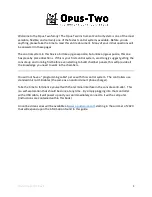
Mini-Seis III Pro™ Operating Manual
Page 9
at the factory for more or less sensitivity. Please check with White or your nearest Mini-Seis
III Pro reseller for the availability of other ranges.
N
ON
-S
TANDARD
S
ENSORS
The Pro does not support the direct display of data from non-standard sensors. However,
the software can display and analyze data from non-standard sensors. The standard sensors
are a tri-axial geophone package and an overpressure microphone.
Non-standard sensors might include accelerometers, strain gauges, hydrophones, etc. We
can supply a bud box with the desired connectors so that individual sensors can be used.
There can be from 1 to 8 non-standard sensors used, depending on the Pro configuration.
Contact White for more information.
A
W
EIGHTING
The Pro can be equipped with a logarithmic amplifier board for non-certified Type 2 A
weighting. We stress non-certified as we cannot test it to certify that it meets ANSI
standards. However, it has been tested and compared with ANSI certified devices. A
separate microphone should be used for A weighting versus linear overpressure. A
weighting is only available for channel 4.
N
EW
F
EATURES
New features may be added. Please check with White or your nearest White Seismograph
reseller at any time for information concerning specific features.
Connectors
The standard 4 channel unit has four connectors, two push-pull connectors for the sensors
and two DB9 connectors. The 8 channel unit has two additional push-pull connectors. On
the 8 channel unit, the connectors closest to the outside of the case represent channels 1
through 4. The inside connectors represent channels 5 through 8. The push-pull sensor
connectors are interchangeable for any channel set.
The female top DB9 is the serial connector. This connector can be used for serial
communication and external charging by an AC or DC source. The male bottom DB9 is the
USB connector. The USB connection generates a high speed virtual com port.
WARNING – Do not attempt to charge the unit using the male DB9. Doing this could cause
significant damage. Always use AC chargers and DC cables supplied by White for external
power. A splitter cable can be provided if both power and serial communication are
needed at the same time.
Connecting a Sensor
To connect a sensor, align the notch of the male connector with the tab in the top of the
female connector and push in until it clicks. To disconnect a sensor, pull back on the sliding
fixture. The connectors are very rugged. However, care should be taken so that significant
amounts of dirt and mud do not become impacted around the pins.









































